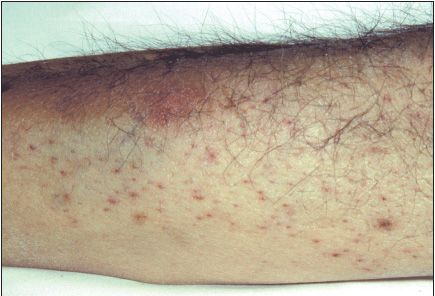Alcoholic man with weakness, fatigue, bleeding gums, and leg lesions
The family of a 50-year-oldalcoholic man brings him to youroffice. They are concerned abouthis health and note that they had notseen him for several months beforehe reappeared. The patient complainsof generalized weakness, fatigue, andbleeding gums.
THE CASE:
The family of a 50-year-old alcoholic man brings him to your office. They are concerned about his health and note that they had not seen him for several months before he reappeared. The patient complains of generalized weakness, fatigue, and bleeding gums.
Which diagnosis comes to mind as you examine the patient’s lower extremities?
- Thrombocytopenia.
- Hypersensitivity vasculitis.
- Scurvy.
- Senile purpura.
(Answer and discussion on next page.)
DISCUSSION: Follicular hyperkeratosis with perifollicular hemorrhage of the lower extremities (particularly the shins) is a characteristic finding in patients with scurvy. Other manifestations include petechiae, purpura (Figure), and corkscrew hairs (fragmented and twisted hairs). Major organ systems may be affected. Gingival hemorrhage, painful hemarthrosis (from bleeding into the joints), anemia (normochromic and normocytic), and cardiac complications are just a few of the possible sequelae of scurvy.

Although evidence of scurvy was recorded as early as 1550 BC by the Egyptians, it was not until 1753 that Sir James Lind demonstrated that adding citrus fruits to the diets of British sailors could prevent this disorder. In 1793, the British Navy approved a preventive dietary regimen that included citrus fruits, and the incidence of scurvy among sailors decreased significantly.
Prolonged deficiency of vitamin C (3 months of severe or total deprivation) results in defective collagen synthesis and underutilization of folic acid and iron. Although scurvy is rare in the United States, it may develop in persons with chronic malnutrition (such as alcoholics) or malabsorption or inflammatory disease.
Scurvy is also seen in infants. Risk factors include the exclusive use of evaporated or condensed milk formulas. Parents may notice irritability, poor weight gain, and pallor. These symptoms rarely develop before the age of 7 months and may be associated with bony abnormalities evident on radiography.
In adults, early symptoms are nonspecific; they may include weight loss, loss of appetite, fever, and tachypnea. More specific findings in later stages of disease may include hemorrhage, arthralgia, and irritability.
Historic features and physical findings usually suffice to make the diagnosis. Laboratory tests (such as leukocyte ascorbate levels and urinary and serum ascorbic acid levels) may be ordered; however, these are not usually needed, often are not readily available, and may be technically difficult to perform. Body stores of vitamin C (more than 350 mg) can be maintained with as little as 6 to 10 mg/d. (One small orange contains 50 mg of vitamin C.)
Institute treatment with oral vitamin C, 800 to 1000 mg/d, for 1 week, then 400 mg/d until recovery is complete. Hemorrhaging stops within 24 hours, and perifollicular petechiae resolve within 2 weeks.
Ruling out other entities. Patients with thrombocytopenia (platelet count less than 100,000/μL) may be asymptomatic, or they may present with spontaneous bleeding (usually associated with a platelet count between 10,000 and 20,000/μL) from any mucosal surface. This may manifest as petechiae, purpura, or confluent ecchymosis. Examination of the peripheral blood smear typically reveals normal morphology with an increased percentage of large platelets. The whole-blood clotting time test is normal, and bleeding time is prolonged.
Hypersensitivity vasculitis (small-vessel vasculitis) may cause a variety of lesions, including ecchymoses, palpable purpura, urticaria, nodules, and necrotic ulcerations. This vasculitis may occur in such disease processes as Henoch- Schnlein syndrome, rheumatoid arthritis, and essential (mixed) cryoglobulinemia.
Senile purpura, thought to be attributable to atrophy of collagen, consists of irregular dark purple areas that most commonly occur on the extensor surfaces of the arms of thin elderly persons. Their skin is freely mobile, and seemingly insignificant stretching of the skin can easily rupture vessels.
References:
FOR MORE INFORMATION:
• Hess AF.
Scurvy, Past and Present.
Philadelphia: JB Lippincott Co; 1920.
•Hirschmann JV, Raugi GJ. Adult scurvy.
J Am Acad Dermatol.
1999;41:895-906.
• Wilson LG. The clinical definition of scurvy and the discovery of vitamin C.
J Hist Med.
1975;30:40-60.